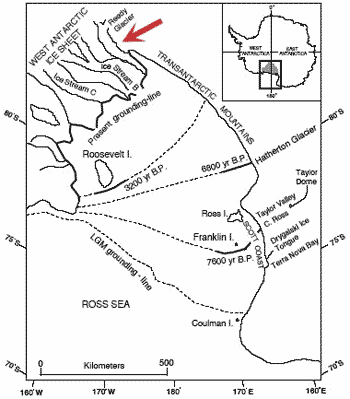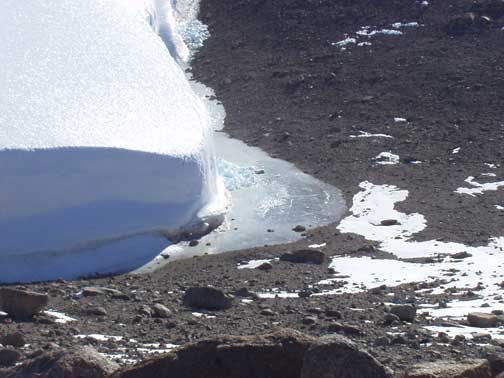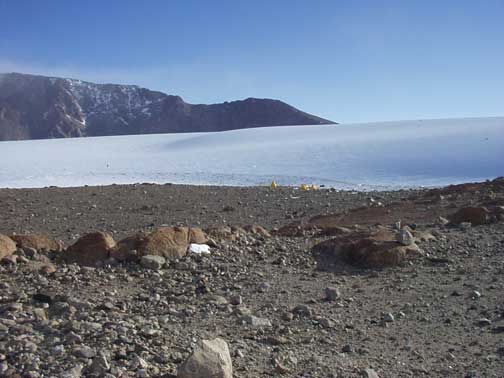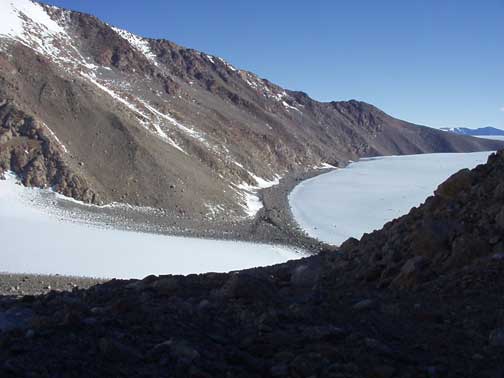Late Quaternary History of Reedy Glacier, Antarctica
Late Quaternary History of Reedy Glacier, Antarctica
Claire Todd, John Stone, Howard Conway, and Maurice Conway (UWashington)
December 15, 2004 – February 1, 2005
We will reconstruct the level of Reedy Glacier, in the far southern Transantarctic Mountains, from the LGM (Last Glacial Maximum) through to the present day. Because the grounding line has not yet passed Reedy Glacier, it, unlike other outlet glaciers crossing the Transantarctic Mountains, will have recorded recent changes in the thickness of ice in the Ross Sea. The deglaciation chronology of Reedy Glacier therefore can indicate whether Holocene retreat of the WAIS (West Antarctic Ice Sheet) grounding-line ended thousands of years ago, or is continuing at the present day. We will carry out an integrated glaciologic, glacial-geologic, and exposure-dating project to map and date past levels of Reedy Glacier. We will map moraines and erratic distributions at sites along the length of the glacier. We will date the moraines directly with cosmogenic isotopes, and, if possible, couple these results with radiocarbon dates on organic material from ice-marginal melt ponds. This will allow us to correlate moraines along the glacier and to establish its gradient through time. We will obtain radar profiles across the glacier at several locations and measure present-day flow speeds with GPS, as the basis for developing a flow-line model to relate our observations to the grounding-line position downstream. Ultimately, the mapping, dating and ice-modeling components of the study will be integrated into a reconstruction that defines changes in ice thickness in the southernmost Ross Sea since the LGM, and relates these changes to the history of grounding-line retreat.
December 12, 2004
Here we are again, back in McMurdo Station for our 2004 field season. We were delayed in Christchurch because of recent warm weather, which has made the sea-ice runway unsafe. So for three days, as the new air strip was being established on the thicker ice shelf, we enjoyed spring in New Zealand. Now we are here we actually have very little to do, given that the rest of our group is already installed at Reedy Glacier with all the equipment and food. Yesterday, we procured a few food items that the others have been requesting from the field and also took the mandatory refresher course, where we review the use of radios, stoves, tents, etc. If the weather holds, we should be on our way to Reedy Glacier tomorrow morning, via the South Pole, and we can get back to work at last.
December 13, 2004
Brenda and I were fortunate enough to hitch a ride in a Twin Otter directly from McMurdo to Reedy Glacier for a happy reunion with the rest of our group, I-175. They had just spent two weeks down at the mouth of the glacier, where it flows into the West Antarctic Ice Sheet, and were ready to move camp with us up to the Quartz Hills. A particularly amusing aspect of a camp move is loading the heavy skidoos into the Twin Otter, a process that involves one of the pilots driving the machine rapidly up a wooden ramp and into the back of the plane, like a stuntman. Everyone stands back as he approaches and then we rush forward to help push the skidoo up the ramp.
Our week in the Quartz Hills was spent finishing off last year’s mapping, as well as covering a lot of new ground. In contrast to the unbroken sunshine of 2003, this year we had to deal with days of low cloud and snow showers, which make camping a little less comfortable and mapping almost impossible. It wasn’t all bad though, sometimes we would find ourselves above the clouds, working in the warm sunshine. Furthermore, in the course of our work in the Quartz Hills we came across many beautiful crystals, such as black tourmalines, red garnets, and rose quartz.
On the 22nd December we packed up our Quartz Hills camp and relocated to Polygon Spur, an isolated chunk of land right up at the head of Reedy Glacier. Because this happened to be a particularly windy day the pilots were not at all sure we’d be able to make a safe landing, but with a well-timed lull in the weather and some great flying skills we did succeed in moving our camp that day. Our new home (see photo), in my opinion, far surpassed the Quartz Hills camp in terms of comfort. For instance, it was sheltered from the wind, always in the sun, and the view from the ‘bathroom’ without compare. Best of all, each morning John would wake me up with a big cup of tea! There could have been improvements, however, for over the course of three weeks the ice beneath the cook tent melted out, leaving a big pond in the middle of the kitchen.
During our three weeks at Polygon Spur our party collected a huge number of rock samples for dating and successfully mapped the relatively complicated landscape. A rather fascinating discovery was the abundance of ice cliffs at the glacier edge, sometimes with little frozen ponds at their bases (see photo). On relatively warm days the cliffs make loud cracking noises and bits fall off, so naturally we did not tend to linger there! In addition, we took a number of daytrips to isolated nunataks out on the edge of the ice sheet. These were intended to locate the former surface level of Reedy Glacier, but typically evolved into cold photography sessions in exotic locations. On a foray to the nearby Tillite Spur, John and Brenda actually found fossilised leaves in the bedrock, evidence that Antarctica was once much warmer than today and covered in trees. Christmas was again a relaxed affair, involving sunbathing (I cannot stress how good the weather was!), catching up on sleep, eating chocolate, climbing hills, calling home on the satellite phone, and eating some more. On the 26th, however, the festivities were over and it was business as usual.
It amazes me how fast time passes when work is going well, you’re in good company, and you’re having fun. This five week season, being no exception, just seemed to fly by! Four days after leaving Reedy Glacier we were out of Antarctica completely and had gone our separate ways. I was swimming in the sea in New Zealand, savouring food that wasn’t dried or out of a can, and just kicking back. It couldn’t have been a more different existence! In all, our field work at Reedy Glacier has been a very productive and amazing experience. Now comes the hard part of piecing together the evidence, writing a thesis and hopefully producing a number of research papers. It’ll be hard not to daydream though, especially when I get the photos back!





